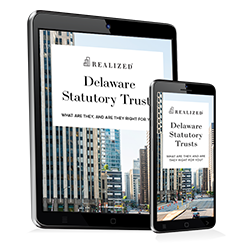The Realized Team’s Picks
What Happens If a Delaware Statutory Trust Sponsor Goes Bankrupt?

Delaware Statutory Trusts (DSTs) are powerful investment vehicles, offering advantages like passive income and potential tax deferral for capital gains taxes. However, these trust entities are not without risk, and one of the most concerning is sponsor bankruptcy. So, what does actually happen if a Delaware Statutory Trust sponsor goes bankrupt?
Is a Delaware Statutory Trust Right for First-Time Real Estate Investors?

Real estate has always been considered a cornerstone of wealth-building, and entering this sector means building a portfolio of diversified assets. First-timers have plenty of options available to them, and some find themselves drawn to Delaware Statutory Trusts (DSTs), which offer benefits including passive income and enhanced diversification.
How Long Does It Take To Set Up a Delaware Statutory Trust?

Entering a Delaware Statutory Trust (DST) is a powerful investment strategy that provides tax-deferral benefits, enhanced diversification, and truly passive income. Before you commit to this route, however, you may have various questions regarding certain aspects of the DST, such as the establishment timeline. How long does it take to set up a Delaware Statutory Trust? Is there a faster way to go about it? Realized 1031 shares the answers to these questions below to help you out.
When Is the Best Time To Invest in a Delaware Statutory Trust?

Entering a Delaware Statutory Trust (DST) is a long-term commitment. While this investment vehicle offers benefits such as tax deferral and passive income, it’s locked into a holding period that can span up to a decade or more. As such, timing is crucial to increase the chances of maximum return on investment. When is the best time to invest in a Delaware Statutory Trust? Realized 1031 looks at DSTs through a macro lens to answer this question. Keep reading to learn more.
Benefits and Drawbacks of Investing in an UPREIT Structure

An umbrella partnership real estate investment trust (UPREIT) is a powerful investment tool that many modern investors are finding appealing. This structure is an operating partnership (OP) owning income-generating property, with the REIT having the controlling interest and investors as limited partners. As you contribute property to the UPREIT, you gain OP units and earn dividends on a regular basis. Since the REIT controls the operations and management of the underlying properties, investors have hands-off involvement and earn without any added effort.
How to Calculate Capital Gains When Selling Partial Ownership of Property

Selling partial ownership of an investment property can be a strategic move for property owners seeking to diversify their portfolio or unlock some value. However, understanding how to calculate capital gains in such scenarios is crucial for effective financial planning and to avoid surprises at tax time. Here’s a concise guide geared toward property owners on how to navigate the calculation.
How to Minimize Capital Gains on a Rental Property Sale

Selling a rental property can be a rewarding venture, but it often comes with the hefty burden of capital gains taxes. These taxes can significantly erode the profits from your sale, which makes finding ways to minimize them critical for maximizing your returns. Here, we'll explore effective strategies to lessen the impact of capital gains taxes on your rental property sale.
Are There Capital Gains Taxes On Cryptocurrency Sales?

In recent years, cryptocurrency has gained immense popularity as an alternative investment, attracting the attention of both investment property owners and traditional investors. However, with this new asset class comes a pertinent question for tax-conscious investors: Are there capital gains taxes applicable to the sale of cryptocurrencies? Understanding the tax implications is crucial as they can significantly impact your overall investment strategy and returns.
Strategies for Handling Capital Gains After Selling A Business

Selling a business can be a momentous occasion, often symbolizing the culmination of years of hard work. However, it also brings forward the challenge of managing capital gains taxes that arise from the transaction. For investment property owners and those familiar with navigating tax implications, strategizing around capital gains can mean retaining more of your hard-earned wealth. Here are effective strategies to consider when handling capital gains after selling a business.



